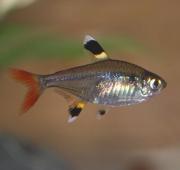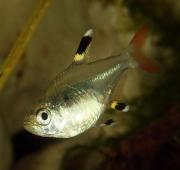 X-Ray Tetra Classification and Evolution
The X-Ray Tetra is a small species of schooling Fish that is naturally found in the Amazon River's coastal waters in South America. The X-Ray Tetra is also known as the Golden Pristella Tetra and the Water Goldfinch due to the faint golden colouration of their translucent skin. They were first described by Ulrey in 1894 and have since become one of the most popular freshwater Fish kept in artificial aquariums today. Although the X-Ray Tetra is the only known species in it's genus, it is closely related to other small and colourful South American Fish, including the nearly 100 other Tetra species.
X-Ray Tetra Classification and Evolution
The X-Ray Tetra is a small species of schooling Fish that is naturally found in the Amazon River's coastal waters in South America. The X-Ray Tetra is also known as the Golden Pristella Tetra and the Water Goldfinch due to the faint golden colouration of their translucent skin. They were first described by Ulrey in 1894 and have since become one of the most popular freshwater Fish kept in artificial aquariums today. Although the X-Ray Tetra is the only known species in it's genus, it is closely related to other small and colourful South American Fish, including the nearly 100 other Tetra species.  X-Ray Tetra Anatomy and Appearance
The most distinctive feature of the X-Ray Tetra is the translucent layer of skin that covers it's small body, allowing the Fish's backbone to be clearly seen. The scales of the X-Ray Tetra are a silvery-yellowish colour that is very faint, looking almost golden in some lights. The X-Ray Tetra also has a re-tipped tail and strikingly striped dorsal and anal fins that are yellow, black and white in colour. This is a relatively small species of Fish that actually has a bony internal structure known as the Weberian apparatus, which is used in picking up sound waves, and contributes to their acute sense of hearing (this bony structure is also found in many of their relatives). Females are generally slightly larger and rounder than the more slender males, although the two are very similar in appearance.
X-Ray Tetra Anatomy and Appearance
The most distinctive feature of the X-Ray Tetra is the translucent layer of skin that covers it's small body, allowing the Fish's backbone to be clearly seen. The scales of the X-Ray Tetra are a silvery-yellowish colour that is very faint, looking almost golden in some lights. The X-Ray Tetra also has a re-tipped tail and strikingly striped dorsal and anal fins that are yellow, black and white in colour. This is a relatively small species of Fish that actually has a bony internal structure known as the Weberian apparatus, which is used in picking up sound waves, and contributes to their acute sense of hearing (this bony structure is also found in many of their relatives). Females are generally slightly larger and rounder than the more slender males, although the two are very similar in appearance.
X-Ray Tetra Distribution and Habitat The X-Ray Tetra is found in the Amazonian coastal waters of Brazil, Guiana, Guyana, and Venezuela in South America. They differ greatly from other Tetra species as they are able to tolerate the harder brackish water closer to the coast, as well as their usual freshwater environments. They inhabit clear-water streams and tributaries during the dry season, and with the coming of the rains, the X-Ray Tetra then move into the flooded marshlands where the water is softer and more acidic. It is during the wet season that the X-Ray Tetra breed as they have better water conditions and a higher abundance of food.
X-Ray Tetra Behaviour and Lifestyle Like many other small, colourful Fish, the X-Ray Tetra is a schooling species of Fish inhabiting the region between the bottom and middle of the water as a group. They are incredibly peaceful and are often tolerant of the other species that they share their habitats with. The X-Ray Tetra is one of the most adaptable species of Tetra as it is able to inhabit both fresh and brackish water happily, in both acidic and alkaline conditions. It is widely observed that those X-Ray Tetra that are kept in tanks, can change quickly from being peaceful to becoming skittish in the presence of larger, predatory Fish, with the same behaviour known to be displayed if the school size is not big enough.
X-Ray Tetra Reproduction and Life Cycles During the rainy season. the X-Ray Tetra return to the flood-lands to spawn. Unlike many similar Fish who give birth to live young, the female X-Ray Tetra lays between 300 - 400 eggs by scattering them amongst the vegetation (when she is ready to spawn, the see-through skin means that her eggs can also be easily seen). X-Ray Tetra fry begin to hatch as early as 24 hours later, and become free swimming within a few days. Once able to swim, the small and dull white young, are able to find better food sources and soon develop their characteristic adult markings. X-Ray Tetra usually live for three or four years in the wild but can get to older ages in captivity.
X-Ray Tetra Diet and Prey Like many other small species of Fish that live in the Amazon River, the X-Ray Tetra is an omnivorous animal whose diet is made up of both animals and plants. X-Ray Tetra primarily hunt Worms, Insects and small Crustaceans that live close to the river bed and their fry tend to feed on Insect larvae. Although they are also known to supplement their diet with aquatic plants, they are predominantly micro-predators that feed on small invertebrates. In artificial communities, X-Ray Tetra need a variety of food sources including Brine Shrimp and Bloodworm alongside the standard flakes and pellets to ensure that they have a fully nutritious diet.
X-Ray Tetra Predators and Threats The small size of the X-Ray Tetra means that they should not be kept in the same aquarium as larger, predatory Fish, but will co-inhabit the tank peacefully with other small, schooling Fish that pose them no threat. In the wild, X-Ray Tetra are preyed upon by a number of aquatic predators including larger Fish and Frogs, and are also threatened by Birds and Snakes if they are closer to the water's surface. Populations are thought to be the most under threat from the rising levels of pollution in the water and habitat loss in general.
X-Ray Tetra Interesting Facts and Features The Weberian apparatus (the bony structure) in the X-Ray Tetra's body works by transmitting sound waves through their vertebrate, that have been received by the swim bladder and are then taken to the inner ear, meaning that the X-Ray Tetra has excellent hearing. The transparency of their skin is thought to be a form of protection as predators find it much harder to spot them (along with their light yellow markings) amongst the dense vegetation, and shimmering water. Not only is the yellowish X-Ray Tetra popular in tanks, but an albino version of the species is also now commonly found in artificial communities worldwide.
X-Ray Tetra Relationship with Humans Since it was first described in 1894, this unique animal has been the subject of much fascination due to it's nearly transparent body. They are now one of the most popular species of tropical Fish to be kept in household tanks, mainly due to their ease of keeping as they are hardy, adaptable and undemanding. Their fast breeding rate is also thought to be one of the reasons why they have become quite so popular. Today, aquarium X-Ray Tetra do not come from the wild, but are instead commercially farmed for the trade, mainly in Eastern Europe and in the Far East.
X-Ray Tetra Conservation Status and Life Today The X-Ray Tetra has not been listed on the IUCN Red List as a species that is under threat in it's environment. However, increasing industry in the Amazon Basin means that there has been an increase in the levels of pollution in the water and therefore a decrease in water quality, leading to slight population declines in certain areas.

